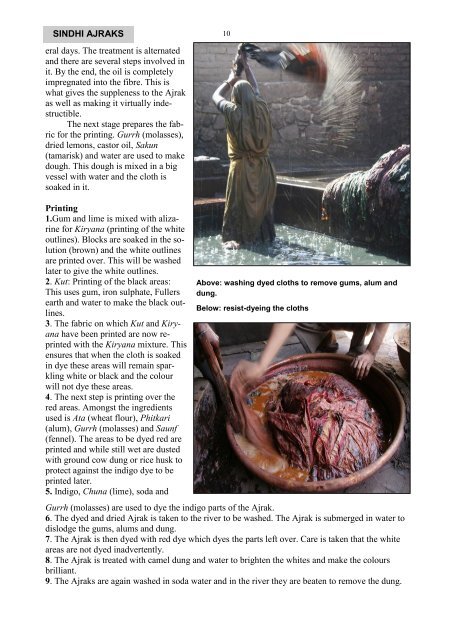download - OATG. Oxford Asian Textile Group
download - OATG. Oxford Asian Textile Group
download - OATG. Oxford Asian Textile Group
You also want an ePaper? Increase the reach of your titles
YUMPU automatically turns print PDFs into web optimized ePapers that Google loves.
SINDHI AJRAKS<br />
10<br />
eral days. The treatment is alternated<br />
and there are several steps involved in<br />
it. By the end, the oil is completely<br />
impregnated into the fibre. This is<br />
what gives the suppleness to the Ajrak<br />
as well as making it virtually indestructible.<br />
The next stage prepares the fabric<br />
for the printing. Gurrh (molasses),<br />
dried lemons, castor oil, Sakun<br />
(tamarisk) and water are used to make<br />
dough. This dough is mixed in a big<br />
vessel with water and the cloth is<br />
soaked in it.<br />
Printing<br />
1.Gum and lime is mixed with alizarine<br />
for Kiryana (printing of the white<br />
outlines). Blocks are soaked in the solution<br />
(brown) and the white outlines<br />
are printed over. This will be washed<br />
later to give the white outlines.<br />
2. Kut: Printing of the black areas:<br />
This uses gum, iron sulphate, Fullers<br />
earth and water to make the black outlines.<br />
3. The fabric on which Kut and Kiryana<br />
have been printed are now reprinted<br />
with the Kiryana mixture. This<br />
ensures that when the cloth is soaked<br />
in dye these areas will remain sparkling<br />
white or black and the colour<br />
will not dye these areas.<br />
4. The next step is printing over the<br />
red areas. Amongst the ingredients<br />
used is Ata (wheat flour), Phitkari<br />
(alum), Gurrh (molasses) and Saunf<br />
(fennel). The areas to be dyed red are<br />
printed and while still wet are dusted<br />
with ground cow dung or rice husk to<br />
protect against the indigo dye to be<br />
printed later.<br />
5. Indigo, Chuna (lime), soda and<br />
Above: washing dyed cloths to remove gums, alum and<br />
dung.<br />
Below: resist-dyeing the cloths<br />
Gurrh (molasses) are used to dye the indigo parts of the Ajrak.<br />
6. The dyed and dried Ajrak is taken to the river to be washed. The Ajrak is submerged in water to<br />
dislodge the gums, alums and dung.<br />
7. The Ajrak is then dyed with red dye which dyes the parts left over. Care is taken that the white<br />
areas are not dyed inadvertently.<br />
8. The Ajrak is treated with camel dung and water to brighten the whites and make the colours<br />
brilliant.<br />
9. The Ajraks are again washed in soda water and in the river they are beaten to remove the dung.

















